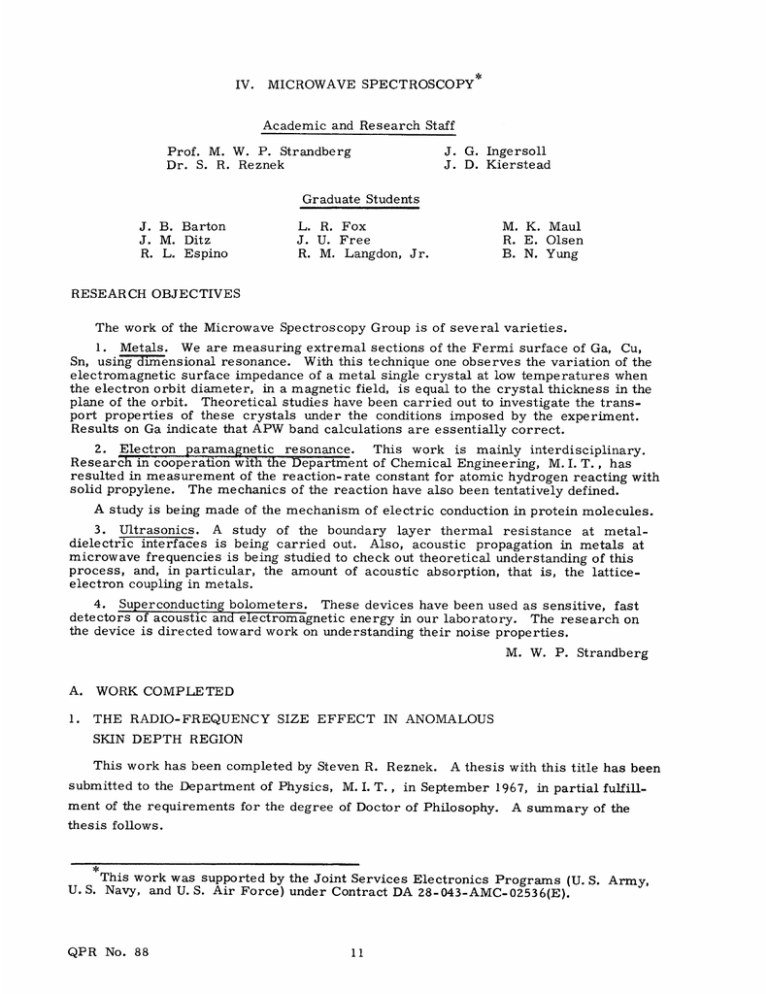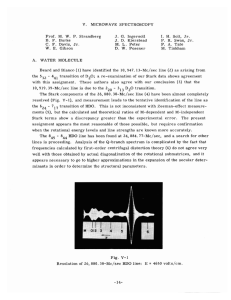IV. MICROWAVE SPECTROSCOPY Academic and Research Staff
advertisement

IV. MICROWAVE SPECTROSCOPY Academic and Research Staff Prof. M. W. P. Strandberg Dr. S. R. Reznek J. G. Ingersoll J. D. Kierstead Graduate Students J. B. Barton J. M. Ditz R. L. Espino L. R. Fox J. U. Free R. M. Langdon, Jr. M. K. Maul R. E. Olsen B. N. Yung RESEARCH OBJECTIVES The work of the Microwave Spectroscopy Group is of several varieties. 1. Metals. We are measuring extremal sections of the Fermi surface of Ga, Cu, Sn, using dimensional resonance. With this technique one observes the variation of the electromagnetic surface impedance of a metal single crystal at low temperatures when the electron orbit diameter, in a magnetic field, is equal to the crystal thickness in the plane of the orbit. Theoretical studies have been carried out to investigate the transport properties of these crystals under the conditions imposed by the experiment. Results on Ga indicate that APW band calculations are essentially correct. 2. Electron paramagnetic resonance. This work is mainly interdisciplinary. Research in cooperation with the Department of Chemical Engineering, M. I. T., has resulted in measurement of the reaction-rate constant for atomic hydrogen reacting with solid propylene. The mechanics of the reaction have also been tentatively defined. A study is being made of the mechanism of electric conduction in protein molecules. 3. Ultrasonics. A study of the boundary layer thermal resistance at metaldielectric interfaces is being carried out. Also, acoustic propagation in metals at microwave frequencies is being studied to check out theoretical understanding of this process, and, in particular, the amount of acoustic absorption, that is, the latticeelectron coupling in metals. 4. Superconducting bolometers. These devices have been used as sensitive, fast detectors of acoustic and electromagnetic energy in our laboratory. The research on the device is directed toward work on understanding their noise properties. M. W. P. Strandberg A. WORK COMPLETED 1. THE RADIO-FREQUENCY SIZE EFFECT IN ANOMALOUS SKIN DEPTH REGION This work has been completed by Steven R. Reznek. A thesis with this title has been submitted to the Department of Physics, M. I. T., in September 1967, in partial fulfillment of the requirements for the degree of Doctor of Philosophy. A summary of the thesis follows. This work was supported by the Joint Services Electronics Programs (U. S. Army, U. S. Navy, and U. S. Air Force) under Contract DA 28-043-AMC-02536(E). QPR No. 88 (IV. MICROWAVE SPECTROSCOPY) Chapter I. tigated. The properties of the transport phenomena in a magnetic field are inves- Interest is centered upon the anomaly in the surface impedance of a metal plate which occurs when the electron orbital diameter is commensurate with the plate thickness - the Radio Frequency Size Effect. The lifetimes of the electrons are considered to be long compared with the cyclotron period, but short compared with the RF period. The orbital diameter and plate thickness are large compared with the skin depth. A method is presented for solving for the distribution function in phase space. The important achievement of this method is that it correctly accounts for the collisions of the electrons with the surface. A line of discontinuity exists in phase space which sepa- rates trajectories that will or will not intersect the surface. This line of discontinuity is the important entity in the RF size effect. The electric and magnetic RF fields in the metal are large only near the surface. They do not decay exponentially, however. This nonexponential decay and the line of discontinuity in the distribution function are responsible for the behavior of the current density at distances commensurate with the orbital diameter. For distances less than one orbital diameter the current density is a constant. For distances greater than one orbital diameter the current density decays with a nonexponential behavior. The behavior of the current density implies that the RF size-effect signal should be smooth for DC magnetic fields smaller than H , but should wiggle for fields greater than H . H is the magnetic field at which the orbital diameter equals the plate thickness. Chapter II. The existing methods for studying the phenomena of the anomalous skin depth were developed to interpret cyclotron resonance. These methods begin by Fourier-transforming the fundamental equations. Any Fourier-transform approach has the fundamental problem of convergence. The surface is a discontinuity and these methods are plagued by Gibb's phenomena. The problem of the electrons in a metal is a quantum-mechanical one. The Hamiltonian for the problem can be converted to an effective free particle HamiltoChapter III. nian by a self-consistent field approximation. The quantum-mechanical transport equa- tions are identical to the classical ones, as long as the potentials do not change rapidly enough to "localize" a particle within its de Broglie wavelength. M. W. P. Strandberg B. REACTION OF ATOMIC HYDROGEN WITH SOLID OLEFIN FILMS AT CRYOGENIC TEMPERATURES The reaction between hydrogen atoms and solid olefins has been studied, by using electron spin resonance spectroscopy, to measure the concentration of atomic hydrogen during the course of the reaction. This experimental project was carried out during the months of June, July, and August 1967. The use of ESR spectroscopy to monitor hydrogen QPR No. 88 (IV. MICROWAVE SPECTROSCOPY) atom concentrations represents a novel and useful approach to the study of the interactions between an atomic species in the gas phase and a reactive solid. The experimental results have been used to determine the radical reaction mechanism and the reaction-rate constants. Moreover, the influence of diffusional processes on the reaction has been noticed experimentally. The experimental results have been successfully used to check the validity of a reaction model based on the premise that hydrogen atoms diffuse throughout and react with the solid olefin film. R. L. Espino QPR No. 88






